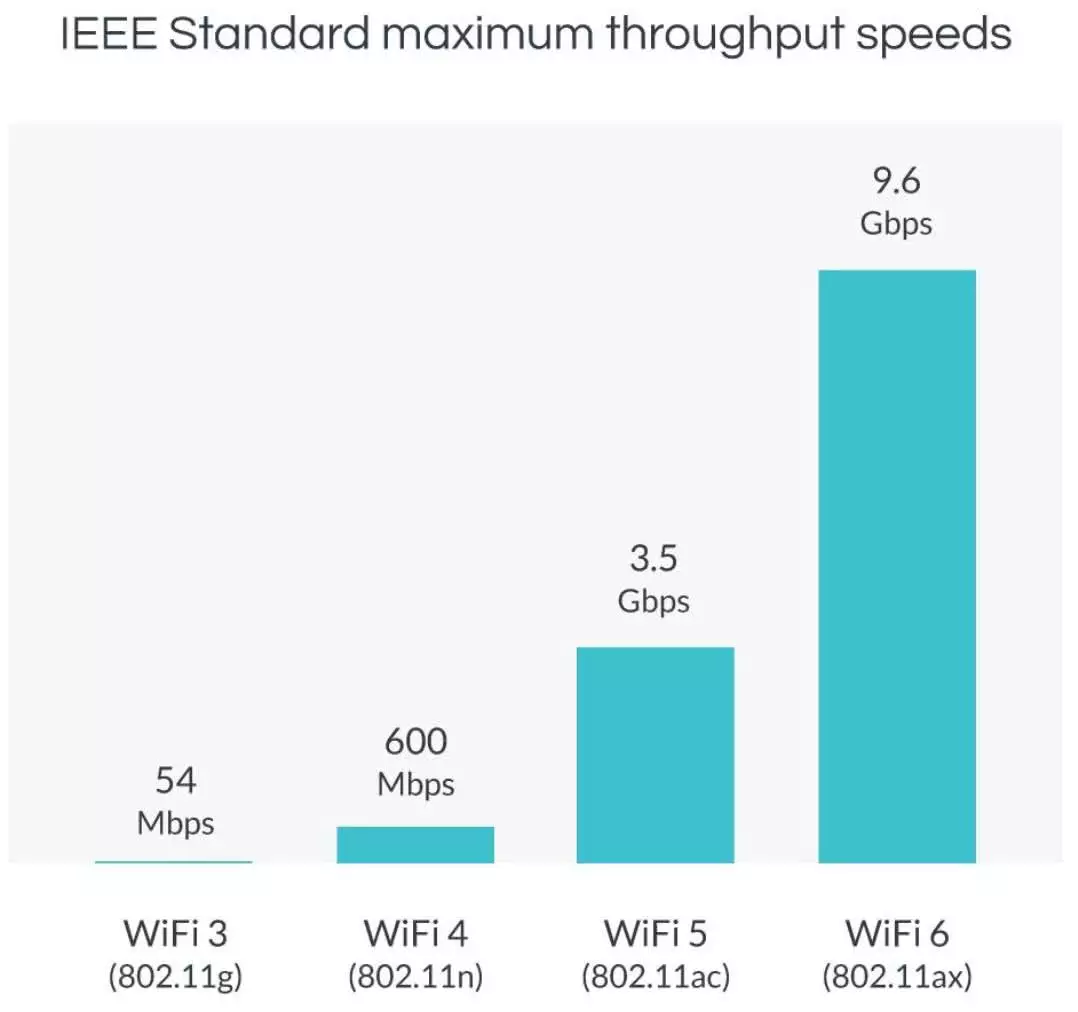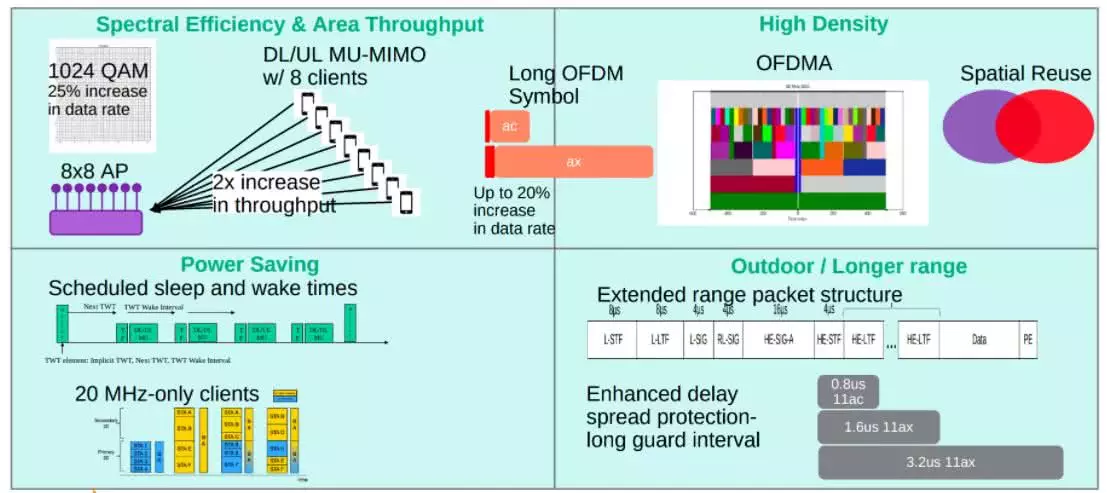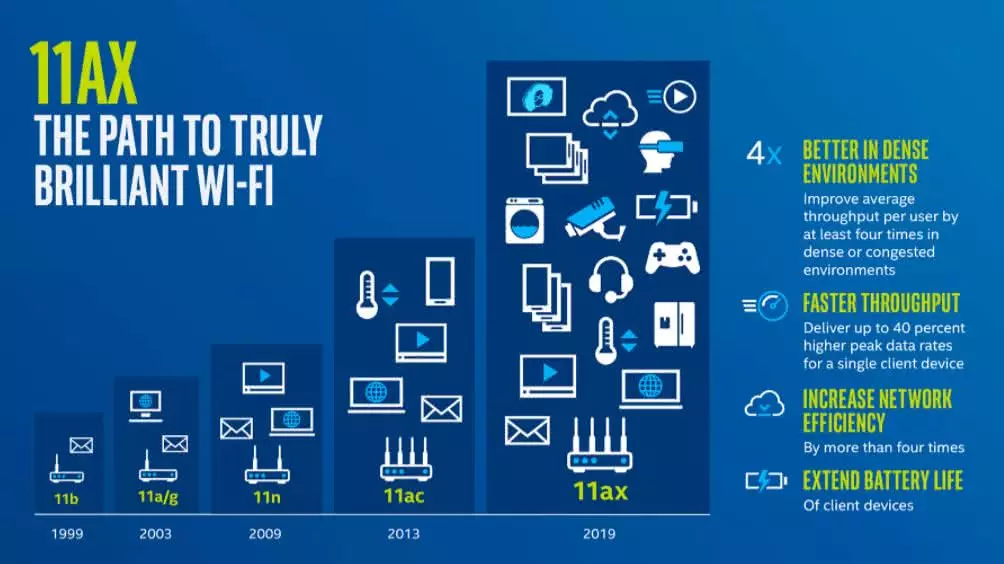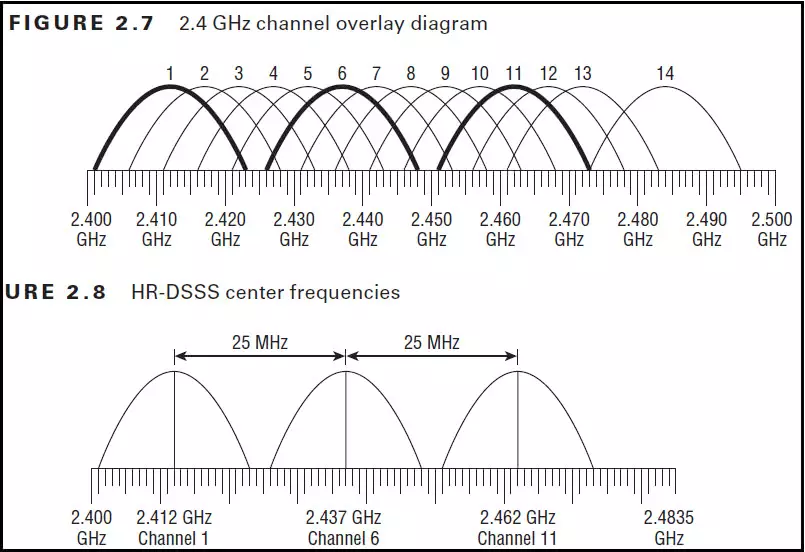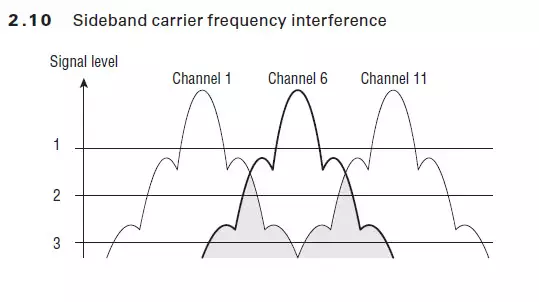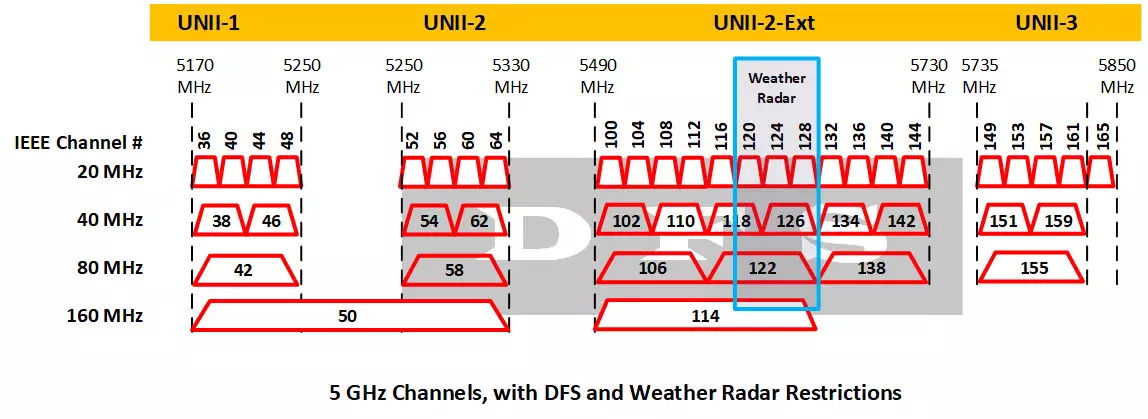Wifi technologies have developed considerably since Wifi was initially released in the year 1997 to consumers. Speeds have increased exponentially and ranges have been boosted to accommodate the increased demand in online collaboration and streaming.
Wifi 1 vs Wifi 2 vs Wifi 3 vs Wifi 4 vs Wifi 5 vs Wifi 6 Technologies
WiFi 1
The Standard IEEE 802.11b is referred to as WiFi 1. This is the first WiFi standard developed by IEEE for Wireless LAN. This WiFi 1 devices operate at 2.4 GHz frequency band and uses DSSS/CCK modulation schemes for data. It provides support for different speed as per mod-code rate viz. 1, 2, 5.5 and 11 Mbps. WiFi-1 supports coverage distances of about 38 meters in indoor and about 140 meters in outdoor environments.
WiFi 2
The Standard IEEE 802.11a is referred as WiFi 2. This WiFi Standard is successor to IEEE 802.11b (i.e. WiFi 1). This is the first wifi standard in which multi carrier modulation scheme i.e. OFDM has been introduced to support high data rates unlike single carrier used in wifi-1. This WiFi-2 version based routers (i.e. APs) and Stations (i.e. clients) operate at 5 GHz RF carrier frequency. This standard based devices support various speed or data rates such as 6, 9, 12, 18, 24, 36, 48 and 54 Mbps due to use of 20 MHz bandwidth. WiFi-2 compliant routers support distance coverage or range of about 35 meters (indoors) and 120 meters (outdoors).
WiFi 3
The Standard IEEE 802.11g is referred as WiFi 3. This WiFi Standard is successor to IEEE 802.11a (i.e. WiFi 2). The WiFi-3 or 11g standard has been developed to support frequency bands of both 11b and 11a standard based devices. It supports 2.4 GHz and 5 GHz frequency bands. It supports all the features as supported by 11a and 11b standards.
WiFi 4
The Standard IEEE 802.11n is referred as WiFi 4. This WiFi Standard is successor to IEEE 802.11g (i.e. WiFi 3). This is the wifi standard in which MIMO has been introduced. Beamforming has been introduced but interoperabilities have not been tested. It supports legacy fallbacks to previous wifi versions viz. wifi-1, wifi-2 and wifi-3. It supports 20 MHz and 40 MHz bandwidths. Due to use of MIMO and higher BW (i.e. 40 MHz) data rates up to 150Mbps can be achieved. WiFi-4 devices can support range of about 70 meters in indoor and about 250 meters in outdoor environments. MIMO configurations supported by WiFi-4 devices include 2T3R and 4T4R. Modulation schemes such as BPSK, QPSK, 16QAM and 64QAM are used.
Some Common Wifi 4 Routers and Access Points we stock:
300Mbps USB Wireless Dongle | Wifi USB Adapter | Wireless LAN
PoE Ceiling Mount Wifi AP | MikroTik cAP Lite 2.4GHz 1.5dBi Access Point
WiFi 5
The Standard IEEE 802.11ac is referred as WiFi 5. This WiFi standard is successor to IEEE 802.11n (i.e. WiFi 4). This is the first wifi standard in which beamforming has been added to the MIMO and multi-user MIMO feature are also introduced. WiFi-5 supports higher throughput due to addition of higher bandwidths ( upto 160 MHz ), multi-user MIMO, higher number of spatial streams ( upto 8) and higher number of modulation schemes (256 QAM). It operates on 5 GHz and supports legacy multi-carrier (OFDM) and single carrier (DSSS, CCK) modulation schemes and baseband modulation types (BPSK, QPSK, 16QAM, 64 QAM, 256QAM) Various channel Bandwidths are supported which include 20 MHz, 40 MHz, 80 MHz and 160 MHz. WiFi-5 supports maximum data rate of 6.93 Gbps ( using 160MHz bandwidth, 8 spatial streams, MCS9, 256QAM, with short guard interval) and coverage range of approx. 80 m with 3 antenna (about 10 meter more than wifi-4). MIMO configuration up to 4 x 4 can be employed. It supports single user transmission as well as multi-user transmissions.
Some Common Wifi 5 Routers, USB Dongles and Access Points we stock:
Wifi 5 Dual Band 2.4Ghz and 5Ghz 650Mbps 6dBi Wireless USB Adapter / Wifi Dongle | Tenda U10
AC Lite POE Wireless Access Point | Dual Band 2.4Ghz & 5Ghz High Speed | Unifi
Wifi 6
WiFi 6 has been released in 2020 to consumers and takes this technology one step further by enabling devices to respond to the wireless access point at the same time, a key ability missing with WiFi 5. WiFi 6 (802.11ax) is the latest generation of WiFi. Building off of the 802.11ac standard for wireless network transmissions, WiFi 6 promises faster throughput speeds, less bandwidth congestion, and WiFi spectrum efficiency. Additionally, while WiFi 5 uses MU-MIMO to allow routers to communicate with four devices at a time, WiFi 6 uses it to allow devices to communicate with up to eight.
WiFi 6 delivers faster speeds than the previous two generations of WiFi, but how much faster is it exactly? WiFi 6 is capable of a maximum throughput speed of 9.6 Gbps, compared to 3.5 Gbps on WiFi 5 and 600Mbps on WiFi 4.
Here’s some of Wi-Fi 6’s main benefits:
- More overall bandwidth per user for ultra-HD and virtual reality streaming
- Support for more simultaneous streams of data with increased throughput
- More total spectrum (2.4GHz and 5GHz, eventually bands in 1GHz and 6GHz)
- Said spectrum split into more channels to enable more routes for communication
- Packets contain more data and networks can handle different data streams at once
- Improved performance (as much as 4x) at the maximum range of an access point
- Better performance/robustness in outdoor and multi-path (cluttered) environments
- Ability to offload wireless traffic from cellular networks where reception is poor
As a point of reference for the changes in Wi-Fi 6, here is what 802.11ac (Wi-Fi 5) expanded on 802.11n (Wi-Fi 4):
- Wider channels (80MHz or 160MHz versus a max of 40MHz in the 5GHz band)
- Eight spatial streams instead of four (spatial streams illustrated)
- 256-QAM versus 64-QAM modulation (transmits more bits per QAM symbol)
- Multi-User MIMO (MU-MIMO) on 802.11ac Wave 2, enabling four downlink connections at once instead of only one on Single-User MIMO (still 1×1 on uplink)
| WiFi Version | Features |
| WiFi 1 | • IEEE 802.11b standard • Speed: 1, 2, 5.5 and 11 Mbps • Range: 38 meters (indoor), 140 meters (outdoor) |
| WiFi 2 | • IEEE 802.11a standard • 6, 9, 12, 18, 24, 36, 48 and 54 Mbps • 35 meters (indoors) and 120 meters (outdoors) |
| WiFi 3 | • IEEE 802.11g standard • Speed : Same as supported by wifi-1 and wifi-2 • Range : Same as supported by wifi-1 and wifi-2 |
| WiFi 4 | • IEEE 802.11n standard • Speed : Maximum up to 150 Mbps • Range : 70 meters (indoor), 250 meters (outdoor) |
| WiFi 5 | • IEEE 802.11ac standard • Speed : 433 Mbits/sec(with 80 MHz and 1 Spatial Streams(SS) ); 6.933 Gbits/sec (with 160MHz, 8 SS) • Range : 80 meters with 3 antennas |
| WiFi 6 | • IEEE 802.11ax standard • Speed : 600.4 Mbits/sec (with 80 MHz, 1 SS); 9.6078 Gbits/sec (with 160 MHz, 8 SS) • Range : Better than wifi-5 routers as beamforming is supported in wifi-6 routers. |
Some Common Wifi 6 Routers, USB Dongles and Access Points we stock:
Gigabit Cudy WiFi6 5Ghz Dual Band Router / Wireless Access Point | WR2100
Ubiquiti Unifi Wifi 6 POE Wireless Access Point | Dual Band UniFi 6 Lite with POE Injector Included
MU-MIMO
WiFi 4 introduced MIMO (Multiple-Input, Multiple-Output) technology, which allows multiple simultaneous transmissions, but only to one device at a time. WiFi 5 built even further on the technology by introducing MU-MIMO, with the added MU standing for Multi-User and enabling multiple users to access a wireless network at the same time without interruption or throttling.
WiFi 6 takes this technology one step further by enabling devices to respond to the wireless access point at the same time, a key ability missing with WiFi 5. Additionally, while WiFi 5 uses MU-MIMO to allow routers to communicate with four devices at a time, WiFi 6 uses it to allow devices to communicate with up to eight.
OFDMA – WIFI6
One of the most important new features of WiFi 6 is OFDMA (Orthogonal Frequency Division Multiple Access), which allows one transmission to deliver data to multiple devices at once. This technology enables a router and its connected devices to utilize bandwidth more efficiently by reducing the time between data transmissions. This results in more bandwidth available for other devices.
Differences between Wifi 5 and Wifi 6
Below are the differences between wifi-5 and wifi-6 with respect to physical layer parameters.
802.11ah
Also known as Wi-Fi HaLow, 802.11ah defines operation of license-exempt networks in frequency bands below 1GHz (typically the 900 MHz band), excluding the TV White Space bands. In the U.S., this includes 908-928MHz, with varying frequencies in other countries. The purpose of 802.11ah is to create extended-range Wi-Fi networks that go beyond typical networks in the 2.4GHz and 5GHz space (remember, lower frequency means longer range), with data speeds up to 347Mbps. In addition, the standard aims to have lower energy consumption, useful for Internet of Things devices to communicate across long ranges without using a lot of energy. But it also could compete with Bluetooth technologies in the home due to its lower energy needs. The protocol was approved in September 2016 and published in May 2017.
802.11ad
Approved in December 2012, 802.11ad is very fast – it can provide up to 6.7Gbps of data rate across the 60 GHz frequency, but that comes at a cost of distance – you achieve this only if your client device is situated within 3.3 meters (only 11 feet) of the access point.
802.11ac (Wi-Fi 5)
Current home wireless routers are likely 802.1ac-compliant, and operate in the 5 GHz frequency space. With Multiple Input, Multiple Output (MIMO) – multiple antennas on sending and receiving devices to reduce error and boost speed – this standard supports data rates up to 3.46Gbps. Some router vendors include technologies that support the 2.4GHz frequency via 802.11n, providing support for older client devices that may have 802.11b/g/n radios, but also providing additional bandwidth for improved data rates.
802.11n (Wi-Fi 4)
The first standard to specify MIMO, 802.11n was approved in October 2009 and allows for usage in two frequencies – 2.4GHz and 5GHz, with speeds up to 600Mbps. When you hear wireless LAN vendors use the term “dual-band”, it refers to being able to deliver data across these two frequencies.
802.11g
Approved in June 2003, 802.11g was the successor to 802.11b, able to achieve up to 54Mbps rates in the 2.4GHz band, matching 802.11a speed but within the lower frequency range.
802.11a
The first “letter” following the June 1997 approval of the 802.11 standard, this one provided for operation in the 5GHz frequency, with data rates up to 54Mbps. Counterintuitively, 802.11a came out later than 802.11b, causing some confusion in the marketplace because eople expected that the standard with the “b” at the end would be backward compatible with the one with the “a” at the end.
802.11b
Released in September 1999, it’s most likely that your first home router was 802.11b, which operates in the 2.4GHz frequency and provides a data rate up to 11 Mbps. Interestingly, 802.11a products hit the market before 802.11a, which was approved at the same time but didn’t hit the market until later.
802.11-1997
The first standard, providing a data rate up to 2 Mbps in the 2.4GHz frequency. It provided a range of a whopping 66 feet of indoors (330 feet outdoors), so if you owned one of these routers, you probably only used it in a single room.
802.11aj
Also known as China Millimeter Wave, this defines modifications to the 802.11ad physical layer and MAC layer to enable operation in the China 59-64GHz frequency band. The goal is to maintain backward compatibility with 802.11ad (60GHz) when it operates in that 59-64GHz range and to operate in the China 45GHz band, while maintaining the 802.11 user experience. Final approval was expected in November 2017.
802.11ak
There are some products in the home-entertainment and industrial-control spaces that have 802.11 wireless capability and 802.3 Ethernet function. The goal of this standard is to help 802.11 media provide internal connections as transit links within 802.1q bridged networks, especially in the areas of data rates, standardized security and quality-of-service improvements. It reached draft status in November 2017.
802.11ax (Wi-Fi 6)
Known as High Efficiency WLAN, 802.11ax aims to improve the performance in WLAN deployments in dense scenarios, such as sports stadiums and airports, while still operating in the 2.4GHz and 5GHz spectrum. The group is targeting at least a 4X improvement in throughput compared to 802.11n and 802.11ac., through more efficient spectrum utilization. Approval is estimated to be in July 2019.
802.11ay
Also known as Next Generation 60GHz, the goal of this standard is to support a maximum throughput of at least 20Gbps within the 60GHz frequency (802.11ad currently achieves up to 7Gbps), as well as increase the range and reliability. The standard is expected to be approved between September and November 2019.
802.11az
Called Next Generation Positioning (NGP), a study group was formed in January 2015 to address the needs of a “Station to identify its absolute and relative position to another station or stations it’s either associated or unassociated with.” The goals of the group would be to define modifications to the MAC and PHY layers that enable “determination of absolute and relative position with better accuracy with respect to the Fine Timing Measurement (MTM) protocol executing on the same PHY-type, while reducing existing wireless medium use and power consumption, and is scalable to dense deployments.” The current estimate on approval of this standard is March 2021.
802.11ba
Otherwise known as “Wake-Up Radio” (WUR), this isn’t a crazy morning zoo-crew thing, but rather a new technology aimed at extending the battery life of devices and sensors within an Internet of Things network. The goal of the WUR is to “greatly reduce the need for frequent recharging and replacement of batteries while still maintaining optimum device performance.” This is currently expected to be approved in July 2020.
2.4Ghz vs 5Ghz Wifi Frequencies
When someone refers to a device as being dual-band, the term indicates that the device has the capability of broadcasting both a 2.4 GHz and 5.8 GHz frequency. The 2.4 GHz radio runs on a lower frequency between 450 Mbps or 600 Mbps. The 5.8 GHz radio can support up to 1300 Mbps. That’s a pretty big difference in wireless speed.
A frequency band is how wireless data is transmitted between devices. These bands are radio waves that transfer the data, and they can be either 2.4 GHz or 5 GHz. The primary difference between 2.4 and 5GHz bands is the range (coverage) and the bandwidth (speed) that these bands provide. For instance, the 2.4GHz band offers coverage at a longer range; however, it transmits data at slower speeds. Instead, the 5GHz band gives less coverage but sends data at faster speeds.
Most devices in your home, including cordless telephones, Bluetooth devices, garage door openers and even baby monitors, run on the 2.4 GHz frequency. The 5.8 GHz frequency, which is a newer standard, is not commonly used in these devices so, dual-band routers are less likely to see interference, from common household devices and access points on the 5.8 GHz frequency. When multiple devices or access points attempt to use the same radio space, overcrowding occurs. The 5.8 GHz band tends to be less crowded than the 2.4 GHz band because fewer devices use it and because it has 23 channels for devices to use, while the 2.4 GHz band has only 11 channels available. The number of channels that are available to you depends on the regulatory domain for your location.
2.4Ghz Channels and overlapping
5Ghz Channels
2.4 GHz Specifications
- Majority of devices use 2.4 GHz
- Has the greatest distance
- Can be crowded because of so many users and less channels (may affect speed)
- May get interference from other devices running on the same band (i.e. microwaves, cordless phones etc.)
5.8 GHz Specifications
- Smaller area of coverage, but usually better speed
- Many devices do not have 5.8 GHz available
- Best way to achieve optimum Wi-Fi performance
- Less range may require more access points for large areas
- Can cause connection issues if all devices are not running on 5.8 GHz
- Preferred for gaming and file streaming because of speed
Dual-band devices Layers:
802.11g = the device will only operate on 2.4 GHz
802.11n = the device will always operate on 2.4 GHz and some may operate on 5.8 GHz
802.11ac = the device will only operate on 5.8 GHz 802.11n is currently used in most devices. Newer devices that use 802.11ac typically offer the option to use 802.11n as well.
Speed : 2.4Ghz vs 5Ghz
The GHz range that a wireless device uses does not necessarily determine the maximum speed of the WiFi. The environment in which the network will be set up is what really should be considered.
For instance, the 2.4GHz band usually supports up to 450 Mbps or 600 Mbps, depending on the device type, however as so many devices use the 2.4GHz band, the resulting congestion can cause discontinued connections and slower speeds.
Instead, the 5GHz band can bear up to 1300 Mbps. It tends to be less overcrowded than the 2.4GHz band because fewer devices use it and because it has more channels for devices to use than the 2.4GHz. The maximum speed would depend on the wireless standard / layer the access point supports, i.e., 802.11b, 802.11g, 802.11n, or 802.11ac.
When comparing the 2.4GHz band with the 5GHz, the latter provides a lower coverage. Thus, when the frequency increases, its ability to penetrate solid objects (like walls) decreases, reason why the 5GHz band was used mostly in outdoor deployments at the beginning. But at the same time, the higher the frequency, the faster the data is transmitted. Therefore, the 5GHz band carries more data and sends it faster. Then, if your priority is to provide an excellent WiFi speed performance, your choice should lean to the 5GHz band, instead.
Interference
The other thing to check for is potential interference with the WiFi network’s frequency range. Interference can slow down a network significantly and reduce its scope as well. For instance, for the 2.4GHz band, the two most obvious sources of wireless network interference are wireless telephones and microwave ovens. Instead, for the 5GHz band, cordless phones, radars, digital satellite and perimeter sensors are the most common sources of interference.
When multiple devices operate on the same frequency, there is usually interference that can affect the signal’s characteristics at the receiving point and reduce the connection speed. Your WiFi connection on a particular frequency band can also be faster or slower because of other devices’ interference.
The waves used by the 2.4GHz band are better suited for longer ranges and transmission through walls and solid objects. Therefore, 2.4GHz is more convenient if you need to provide a better scope on your devices or have many walls or other objects where you need coverage.
On the other hand, the 5GHz band’s shorter waves make it less capable of going through walls and solid objects. This happens because of electromagnetic waves’ peculiar characteristics: at higher frequencies (5GHz), waves attenuate stronger. Hence, the signal is easily influenced by multiple obstacles like walls, floor, ceiling, doors, and others.
Overall, 5GHz WiFi frequency experiences fewer interferences from other devices than WiFi connections using 2.4GHz. Therefore, if your WiFi network is located where there are many interferences from other devices/appliances, it will slow down your connection; thus, we would suggest steering your devices to the 5GHz WiFi frequency. But, if you want to deliver more signal coverage, then use the 2.4 GHz frequency instead.
As a side note, when using the 5GHz frequency band, the client device (smartphone, tablet, laptop, or USB adapter) must support this frequency.
Congestion
When multiple devices attempt to use the same radio space, overcrowding happens. A negative connotation of the 2.4GHz band is its significant congestion driven by the high use of this band not only for WiFi but also for other devices, like garage door openers, microwave ovens, cordless phones, and Bluetooth devices.
On the other hand, the 5GHz band is not so overcrowded, and it has more free radio air and channels, i.e., 23 working channels vs. 11 in the 2.4GHz band. Consider that channel availability depends on the country in which the deployment is located, which results in higher stability and connection speed.
5GHz WiFi Disadvantages
There are some disadvantages to going to a 5GHz wireless network. One is that the higher the frequency of a wireless signal, the shorter its range. For example, 2.4 GHz networks cover a substantially larger range than 5 GHz wireless networks. 5 GHz networks do not penetrate solid objects such as walls nearly as well as do 2.4 GHz signals. This can limit an access points reach inside buildings like homes and offices where many walls may come between a wireless antenna and the user.
Another disadvantage is that 5GHz equipment does not readily mix with 2.4GHz equipment already installed. This is a consideration if you’re upgrading a current large wireless network installation. If you wanted to mix an already installed 2.4GHz network with a 5GHz network, you would have to make sure all components of the network is dual band.
Cost is another factor. The popularity of 2.4GHz means that wireless network components such as access points, antennas and network cards are more easily available and costs less.
One perceived advantage of a higher frequency is speed. However, 5GHz networks are not necessarily faster than 2.4GHz. There are 2.4GHz products using 802.11g that can match or can be faster that 5GHz 802.11a by using paired radios inside access points instead of one which can increase capacity up to 108Mbps.
Which Network?
As you can probably see, switching to 5GHz requires planning. There are a few things to consider before making the jump. In general, if high performance and over crowding of other 2.4GHz networks in the area is an important factor, then 5GHz wireless network may be the answer. However, If you have little control of what network cards your users are using or of access points, then a 2.4GHz system may be a better choice.
Have It Both Ways – Dual Band Wireless Networking
Unless you control and limit the devices used on your network, a dual band network works best. If, on your network, you have 5GHz equipment AND anyone might use devices like iPads, iPods, WiFi enabled smart phones and other devices that can only use 2.4GHz, dual band routers will be required. Dual band equipment that covers both 2.4GHz and 5GHz is ideal and covers the best of both worlds. If the cost is within your budget, a dual band wireless network should be considered.
Below some Dual Band Access Points and Routers we sell:
Tenda Wifi 6 Router | Dual Band 5Ghz & 2.4Ghz 1500Mbps Gigabit Router | W-TX2PRO
Cudy AC1200 Gigabit Dual Band 2.4Ghz & 5Ghz Smart WiFi 5 Router | WR1300
